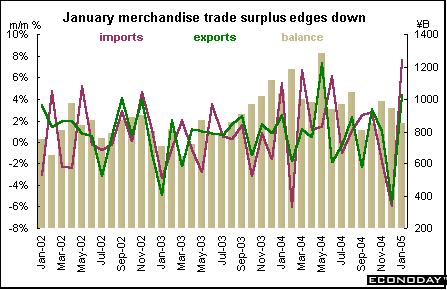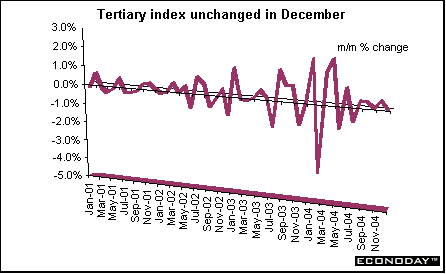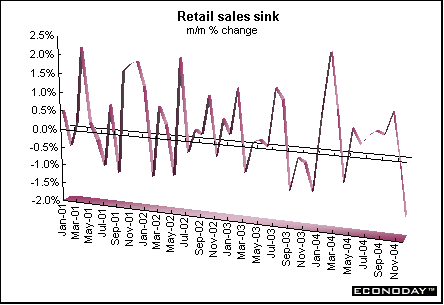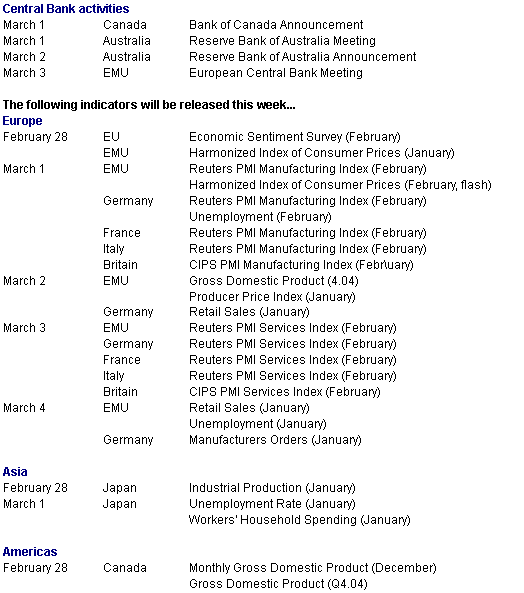Monday, February 28, 2005

Global Markets
As oil prices crept up towards - and vaulted over - $50 a barrel, investors despaired and sold stocks. And the recent positive attitude toward the dollar eroded as well, with the dollar sinking against the euro, yen and pound sterling. In the U.S., economic data were overshadowed by the minutes of the Fed's meeting earlier this month. In the minutes, the FOMC fretted about rising inflationary pressures and certainly led readers to believe that the Fed Funds rate, currently at 2.5 percent, will continue to climb. Thanks to strong rallies on Friday, most indexes managed to recover losses from earlier in the week. Nine of 13 indexes followed here were up on the week.
Global Stock Market Recap

Europe and Britain
It was very dreary for most of the week for British and European stocks. But that didn't last for long as the FTSE and its European compatriots rallied on Friday to regain much of the week's losses. After peaking on February 21st, the FTSE gave back all of its recent gains, fell below 5000 and sank to its February 7th level - only to regain its hold above the 5000 level again on Friday. Contributing to the earlier declines was the sharp increase in crude oil prices to over $50 a barrel for the first time since October. Some of the decline in stocks was attributed to earnings reports that mostly met expectations but did not surprise on the upside. With one more trading day remaining in February, all three indexes are above their January close.

50-year bonds debut
Strong demand for France's 50-year bonds showed the market's appetite for longer-dated assets. France became the first Group of Seven country to issue a 50-year bond in modern times, extending the duration in the market from the 30-year segment. Strong demand for the bonds, which will mature in April 2055, was initially driven by institutional investors including pension and insurance funds which need longer dated assets to match their liabilities from an aging population. Timing of the issue was attractive to France as Eurozone government bond yields have fallen to record low levels recently, offering the government new funds at historically cheap levels. The bond will pay an annual interest of 4 percent and was priced to yield 4.21 percent. Germany, Italy and Britain are considering issuing similar long-dated bonds.
Asia/Pacific
Equities had their ups and downs last week, with the Korean Kospi both gaining and losing the most, depending on the day of the week. After three losing days, the Nikkei managed to lift itself into positive territory, but not quite enough to gain on the week. Positive performances by U.S. stocks along with investor sentiment helped improve the equity outlook. U.S. stocks recovered from sharp losses on Tuesday on better-than-expected CPI figures and news that Asian central banks might diversify their reserves from U.S. dollars (see discussion below in currencies). On Friday, investors bought exporters' stocks as they anticipated the upward revision of U.S. fourth quarter GDP data. With one day of trading remaining, all six Asia/Pacific indexes followed here have gained this month.

Currencies
We are accustomed in the U.S. to look mainly at a given currency vs. the dollar. However, other moves between currencies not involving the dollar impact a currency too. Recently the yen has been under attack as bearish traders think the currency will fall against the euro as well as the dollar. The yen is down 4 percent since reaching a five-year high of 101.67 yen per dollar on January 17th. Against the euro, the yen is down 4.5 percent. Japan's fourth quarter GDP data punctuated the gloom - preliminary data showed that the economy sank into its fourth recession since 1991.

On Tuesday, the U.S. dollar sank after South Korea re-ignited the market's latent fear that central banks are planning to diversify their foreign exchange reserves away from the dollar and to other currencies such as the euro. On Monday, the Bank of Korea said that as its foreign exchange reserves increase, they will diversify investments based on currencies as well as target higher yielding investments. As of December, South Korea had about $200 billion of foreign exchange reserves with about $69 billion invested in U.S. Treasuries. The Bank retracted its statement on Wednesday after stocks sank. South Korea's central bank made it clear that it did not intend to sell dollar assets, just to buy fewer in the future.
Asia's foreign exchange reserves have risen rapidly in recent years to top $2.3 billion as central banks have intervened in the currency markets and bought dollars to stop their own currencies from appreciating. Strong trade surpluses and inward investment inflows have also aided reserve accumulation. With the vast majority of these reserves held in dollar-denominated assets, the dollar is vulnerable to any moves in Asia to spread risk by reducing the proportion of reserves held in dollar assets. Some countries, such as Russia have already embarked on such a process, and traders are concerned that China and other Asian banks might follow suit.

Crude oil prices spook again
Oil prices climbed above $50 a barrel for the first time since October, fuelled by a cold snap in Europe and miserable weather in the Northeast along with ever increasing Asian demand. OPEC's president tried to reassure markets that prices would not get much higher. But prices remained stubbornly above $50, even despite a gain in U.S. crude inventories. The continued cold snap across Europe and the Northeast has boosted heating oil prices and put pressure on fuel stores. And the Saudi oil minister said the price will probably remain between $40 and $50 for the rest of the year.

Indicator scoreboard
EMU - December seasonally adjusted merchandise trade surplus increased to �4.2 billion from �3.4 billion in November. Exports were down 0.6 percent while imports dropped 1.4 percent. On an unadjusted basis, the merchandise trade surplus jumped to �5.7 billion from �2.7 billion in November. Unadjusted exports were up 9 percent on the year while imports were up 11 percent.

December seasonally adjusted new industrial orders soared 8.8 percent and 17 percent when compared with last year. All major product categories were up on the month with transport equipment up 21 percent, machinery & equipment up 6.5 percent and electrical & electronic equipment up 2.5 percent.
January M3 money supply growth was up 0.6 percent and 6.6 percent when compared with last year. For the three months through January M3 was up 6.3 percent when compared with the same three months a year ago. M3 continues to grow at a much stronger rate than the ECB's target of 4.5 percent.

Germany - Fourth quarter gross domestic product declined 0.2 percent but was up 0.6 percent when compared with the same quarter a year ago. The quarterly decline was due primarily to lower inventories that more than offset an improvement in net exports. Domestic demand was down 0.8 percent even though consumer spending edged up 0.2 percent. Total investment also edged up 0.2 percent despite a 0.4 percent drop in equipment investment. Government consumption was down 0.7 percent.

February Ifo Institute business sentiment index dropped to 95.5 from 96.4 in January. Current conditions declined to 94.5 from 95.3 in the previous month while future expectations were down to 96.4 from 97.5 in January. Ifo said that while the precise influence of oil cannot be extracted from the data, they thought it had contributed to the index's decline. The business climate was down in all four industry sectors - manufacturing, wholesale, retail and construction.

December seasonally adjusted industrial production excluding construction was revised downward to an increase of 0.6 percent from an originally reported increase of 0.9 percent. Manufacturing output was up 0.2 percent instead of the originally reported 0.9 percent. Capital goods output was revised to a decline of 1.7 percent rather than the originally reported drop of 2.9 percent. Basic goods output was revised to an increase of 1.3 percent from the originally reported 3.4 percent.

France - January consumer spending on manufactured goods jumped 1.5 percent and was up 3.8 percent when compared with last year. Household durable sales jumped 3.8 percent while other manufactured goods increased by 2.3 percent. Auto sales were down 2.8 percent.

January seasonally adjusted unemployment was up 23,000, pushing the unemployment rate to 10 percent from 9.9 percent in the previous month. The jump in unemployment lifted the number of jobless to a 63-month high according to the International Labour Organization definition which excludes jobseekers who did any work during the month.

January producer price index was up 0.3 percent and 2.8 percent when compared with last year. Excluding food and energy, the PPI was up 0.5 percent and 2.6 percent on the year. Semi-finished goods prices were up 0.7 percent, capital goods prices up 0.5 percent, autos up 0.4 percent and consumer goods, 0.3 percent.

Italy - December retail sales were unchanged and down 0.5 percent when compared with December of 2003. On the year, the drop was due to declining non-food sales and only a small gain in food sales, which account for about 40 percent of the overall index.

Britain - Fourth quarter gross domestic product was up 0.7 percent and 2.9 percent when compared with the same quarter a year ago. Household spending slowed to an increase of 0.4 percent and 2.7 percent on the year. However, government spending was up 0.8 percent and jumped 3.5 percent on the year. Investment spending was up 1.4 percent and 6 percent on the year.

Asia
Japan - January seasonally adjusted merchandise trade surplus was �854.5 billion, down from �945.4 billion in December. Exports were up 4.3 percent but imports jumped 7.6 percent. On an unadjusted basis, the trade surplus was �200.8 billion. Exports were up 3.2 percent while imports soared 11.6 percent on the year. Exports to the U.S. fell 1.6 percent from a year earlier while exports to the E.U. dropped 6.8 percent. Shipments to Asia rose 7.9 percent.

December tertiary index which reflects activity in the service sector was flat on the month but up 2.2 percent when compared with last year. The all industry index dropped 0.3 percent and was up 1.6 percent on the year. The all industries index is considered a close approximation of gross domestic product as measured by the supply side. The all industry index combines the tertiary index with activity in construction, agricultural and fisheries industries, the public sector and industrial output.

February Tokyo consumer price index was down 0.2 percent and dropped 0.5 percent when compared with last year. Tokyo core CPI, which excludes fresh food, was down 0.1 percent and sank 0.5 percent on the year. Nationwide January CPI sank 0.5 percent and was down 0.1 percent on the year. The nationwide core CPI plunged 0.8 percent and dropped 0.3 percent on the year.

Americas
Canada - December retail sales plummeted 1.4 percent but were up 6.6 percent when compared with last year. Most of the decline was due to a combination of sinking auto sales and sales of alcoholic beverages (beer, wine and liquor). The decline in food and beverage was attributed to labor disputes in the National Hockey League and at the Quebec provincial liquor control board. Excluding gasoline sales and auto sales, retail sales sank 1.1 percent. Sales were up for clothing & accessories, music & books, furniture and home electronics & supplies.

January seasonally adjusted consumer price index was down 0.1 percent but up 1.9 percent when compared with last year. Core CPI was up 0.1 percent and up 1.2 percent on the year. The Bank of Canada core CPI, which excludes the eight most volatile index components, was down 0.1 percent and up 1.6 percent on the year. Prices for travel tours, some fresh vegetables and purchase & leasing of automotive products declined. These were offset somewhat by increases in the prices for gasoline and non-alcoholic beverages.

Bottom line
Markets last week were spooked by high oil prices and worries that Asian central banks would not continue to buy American (bonds, dollars). The ease with which the markets dropped only emphasizes how close to the surface investor insecurities are.
Next week begins a new round of central bank meetings, starting with the Bank of Canada announcement on Tuesday, followed by the Reserve Bank of Australia announcement on Wednesday and the European Central Bank on Thursday. It is expected that all three will maintain the status quo and keep their policy interest rates at 2.5 percent, 5.25 percent and 2 percent, respectively.
Looking Ahead: February 28 through March 4, 2005




